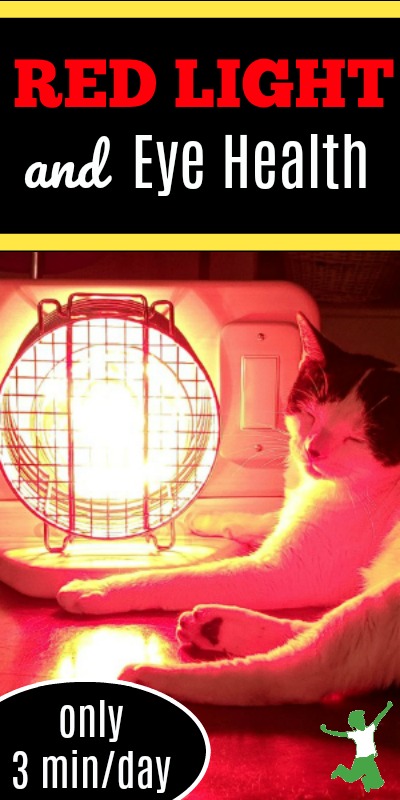Table of Contents[Hide][Show]
How just a few minutes of exposure per day to near-infrared light in the visible red spectrum can improve age-related vision decline especially in those who are over 40 years old according to a recent study.
The retina ages faster than any other organ of the body according to neuroscience professor Glen Jeffery of University College London’s Institute of Ophthalmology.
While adults over age 40 are at the highest risk for diseases such as cataracts, diabetic retinopathy, glaucoma, and age-related macular degeneration, younger people are increasingly starting to see the ravages of aging eyes as well.
An antioxidant-rich, ancestral diet can help preserve eyesight and stave off symptoms. However, it doesn’t help that many of us are staring at phone and computer screens much of the day. These technologies are heavy on blue light, known to disrupt our sleep and contribute to a gradual decline in eyesight over time.
How do we combat this, since doing without screen-based electronics is virtually impossible today unless you are living off-grid in a self-sustaining homestead?
Red Light and Eyesight
A few years back, I wrote about how an EMF-free, near-infrared sauna got rid of my eye floaters which I’d had as long as I could remember.
I was shocked as this was never something I expected when I began a regular, in-home sauna routine, primarily to assist with detoxification.
And yes, they are still gone!
Now, science is starting to provide some answers according to a study published in the peer-reviewed Journal of Gerontology. (1)
Just a few minutes a day of exposure to red light can have a dramatic, rejuvenating effect on vision.
Researchers recruited 12 men and 12 women, with ages ranging from 28 to 72. Each participant was given a small handheld flashlight that emitted a visible red light with a wavelength of 670 nanometers.
Each person spent a scant three minutes each day looking into the light over a period of two weeks.
Incidentally, this wavelength is exactly what is provided in a near-infrared sauna powdered by incandescent heat lamps. By contrast, far-infrared or “full-spectrum” saunas use red LED lights. This type of bulb produces less reliable “digital” monochromatic light. In other words, they selectively emit a fraction of the mitochondrial stimulating light band. They are also typically quite high in EMFs.
Cones and Rods
Exposure to the red light for just a few minutes each day improved both the cones and rods in the eye according to the researchers.
Cones are photoreceptor cells that detect color and work best in well-lit situations. Rods are the retinal cells that specialize in helping us see in dim light. They are more plentiful than cones.
Researchers measured the cone function in subjects’ eyes by having them identify colored letters with low contrast. They also measured rod sensitivity by asking participants to detect light signals in the dark.
All study participants experienced a 14% improvement in the ability to see colors or cone color contrast sensitivity.
Those over 40, however, experienced a more significant 20% improvement in just two weeks. The over-40 age bracket also enjoyed a big jump in the function of the eye rods, as signified by the ability to see low light.
Mitochondria Rejuvenation
This study builds upon animal studies since 2015 that demonstrate the rejuvenating ability of red light upon the mitochondria in eye cells. (2, 3)
The mitochondria is the “battery” of each cell determining, to a great extent, how effective it is at executing its specialized purpose within the body. Mitochondria influence the pace of aging via adenosine triphosphate (ATP).
ATP is an organic compound that provides energy to drive many processes in living cells. It declines precipitously with age. Over the average lifetime, ATP production crashes by 70%.
This decline is intensely experienced with a deterioration in vision. Mitochondrial density is greatest in photoreceptors of the eye, particularly cones that have high energy demands and mediate perception of color vision.
In fact, our retinas have the highest mitochondrial concentration of any part of the body.
Reversing this decline by 20% in only two weeks via exposure to red near-infrared light is an enormous breakthrough. Moreover, these benefits are easily accessible to everyday people and inexpensively put into practice.
Very Safe Therapy
One of the best characteristics of red light is that it is safe according to Dr. Jeffery. “If you use this every day, we have no evidence to say it’s detrimental.”
A double-blind, placebo-controlled study and FDA approval for use of handheld red light devices to improve eye health are necessary as next steps. However, those of us aware of this preliminary research can reap the health benefits to our eyes now.
An incandescent, near-infrared sauna is a very affordable solution compared to going to a local spa for regular sessions or owning a home at the beach to watch the sunset.
Given my personal experience of eye floaters that disappeared within weeks of incandescent near-infrared sauna use and remain gone years later, the beneficial effects of red light exposure may yet prove to be long-lasting as well.
References
(1) Journal of Gerontology, Optically Improved Mitochondrial Function Redeems Aged Human Visual Decline
(2) Near-infrared light increases ATP, extends lifespan and improves mobility in aged Drosophila melanogaster
(3) Aging retinal function is improved by near-infrared light (670 nm) that is associated with corrected mitochondrial decline









Hi Sarah, thank you for writing this article. Do you recall which product you purchased from sauna.space for your home EMF-free, near-infrared sauna?
I have the Luminati model. I also have the Photon sauna with the single heat lamp for portable use.
Thank you for your reply Sarah. Did you use any eye protection during the sessions that resolved your floaters, and did you face the bulbs/look at them? Lastly, how long was each session?
Sessions are usually 20-40 minutes. I don’t wear any eye protection as the near infrared light is good for eye health. I do not look at the bulbs purposely, but just sit in the sauna normally and read a book or listen to music.
Hi Sarah,
Would the light from a campfire have the same benefits as near-infrared sauna light? Just curious. We have a wood stove with a window that lets the light through and I’ve noticed I feel better and sleep better when I spend some time in front of the fire before bed.
By the way – for years we’ve used a software called “Flux” on our computer to reduce the blue light from our screen. It syncs w/ daylight hours, so the screen is more orange when it’s dark outside.
Thanks,
Katie
A campfire is a combination of visible light and far infrared waves, I’m pretty sure.
I just purchased a block blue light power panel – claims its flicker free and very low EMF. I am wondering if the portable bulb you have would be a safer option?
Thank s
Sarah,
We got a Clearlight Sauna a few years ago. We read up and down and got some recommendations. They are supposed to be full spectrum and low EMF. Can you tell me if the light they put out will be good for getting rid of floaters? I don’t use it because it made me too hot and I couldn’t stand it but I would try again if it would get rid of the floaters. We spent a lot and cannot afford to replace it so if it won’t work, what can we do instead? Is there a small unit we can use? I have horrendous floaters and am really having trouble reading lately. Thanks!
Hi Becky, the “full spectrum” saunas are actually far infrared and typically have LED lights (with an EMF field) that can trigger “flicker fatigue”. The sauna I use and that resolved my floaters is a near infrared sauna that uses incandescent bulbs and zero EMF. Here is more information on the differences. https://www.thehealthyhomeeconomist.com/infrared-sauna-review/